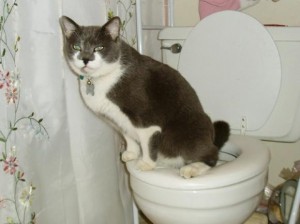Why Flushing Cat Poop Down Your Toilet Isn't a Good Idea - Advice for Proper Handling
Why Flushing Cat Poop Down Your Toilet Isn't a Good Idea - Advice for Proper Handling
Blog Article
This article in the next paragraphs about Can You Flush Cat Poo or Litter Down the Toilet? is exceedingly interesting. Don't bypass it.

Intro
As pet cat owners, it's necessary to bear in mind just how we throw away our feline buddies' waste. While it may appear hassle-free to flush feline poop down the toilet, this practice can have harmful repercussions for both the atmosphere and human health and wellness.
Ecological Impact
Purging feline poop presents unsafe pathogens and parasites into the supply of water, positioning a considerable danger to aquatic environments. These impurities can negatively affect marine life and compromise water quality.
Wellness Risks
In addition to environmental concerns, purging feline waste can likewise present health risks to humans. Pet cat feces might consist of Toxoplasma gondii, a bloodsucker that can cause toxoplasmosis-- a possibly extreme ailment, especially for expecting women and individuals with damaged body immune systems.
Alternatives to Flushing
Thankfully, there are safer and a lot more liable methods to take care of feline poop. Take into consideration the adhering to options:
1. Scoop and Dispose in Trash
The most usual technique of getting rid of cat poop is to scoop it right into a naturally degradable bag and throw it in the trash. Be sure to use a specialized clutter scoop and get rid of the waste promptly.
2. Usage Biodegradable Litter
Opt for biodegradable pet cat trash made from materials such as corn or wheat. These litters are environmentally friendly and can be safely thrown away in the trash.
3. Hide in the Yard
If you have a lawn, consider burying pet cat waste in an assigned area away from veggie gardens and water resources. Be sure to dig deep adequate to avoid contamination of groundwater.
4. Mount a Pet Waste Disposal System
Buy a pet garbage disposal system specifically made for pet cat waste. These systems utilize enzymes to break down the waste, decreasing odor and environmental effect.
Conclusion
Liable family pet ownership prolongs past giving food and shelter-- it also includes correct waste management. By refraining from flushing cat poop down the bathroom and going with alternative disposal techniques, we can lessen our ecological impact and safeguard human wellness.
Why Can’t I Flush Cat Poop?
It Spreads a Parasite
Cats are frequently infected with a parasite called toxoplasma gondii. The parasite causes an infection called toxoplasmosis. It is usually harmless to cats. The parasite only uses cat poop as a host for its eggs. Otherwise, the cat’s immune system usually keeps the infection at low enough levels to maintain its own health. But it does not stop the develop of eggs. These eggs are tiny and surprisingly tough. They may survive for a year before they begin to grow. But that’s the problem.
Our wastewater system is not designed to deal with toxoplasmosis eggs. Instead, most eggs will flush from your toilet into sewers and wastewater management plants. After the sewage is treated for many other harmful things in it, it is typically released into local rivers, lakes, or oceans. Here, the toxoplasmosis eggs can find new hosts, including starfish, crabs, otters, and many other wildlife. For many, this is a significant risk to their health. Toxoplasmosis can also end up infecting water sources that are important for agriculture, which means our deer, pigs, and sheep can get infected too.
Is There Risk to Humans?
There can be a risk to human life from flushing cat poop down the toilet. If you do so, the parasites from your cat’s poop can end up in shellfish, game animals, or livestock. If this meat is then served raw or undercooked, the people who eat it can get sick.
In fact, according to the CDC, 40 million people in the United States are infected with toxoplasma gondii. They get it from exposure to infected seafood, or from some kind of cat poop contamination, like drinking from a stream that is contaminated or touching anything that has come into contact with cat poop. That includes just cleaning a cat litter box.
Most people who get infected with these parasites will not develop any symptoms. However, for pregnant women or for those with compromised immune systems, the parasite can cause severe health problems.
How to Handle Cat Poop
The best way to handle cat poop is actually to clean the box more often. The eggs that the parasite sheds will not become active until one to five days after the cat poops. That means that if you clean daily, you’re much less likely to come into direct contact with infectious eggs.
That said, always dispose of cat poop in the garbage and not down the toilet. Wash your hands before and after you clean the litter box, and bring the bag of poop right outside to your garbage bins.
https://trenchlesssolutionsusa.com/why-cant-i-flush-cat-poop/
Do you really like more info about Can You Flush Cat Poop Down The Toilet?? Give a remark down below. We would be pleased to know your ideas about this blog entry. Hoping to see you back again before long. I beg you take the time to share this article if you enjoyed reading it. I love reading our article about Don’t flush cat feces down the toilet.
Schedule Services Report this page